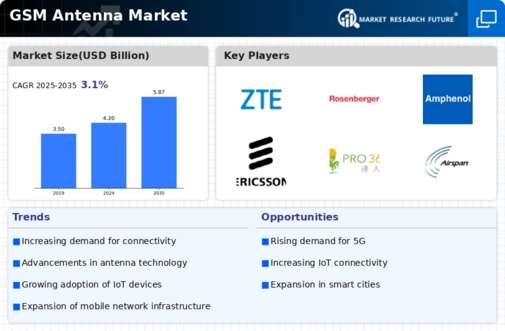Increased Adoption of Smart Devices
The proliferation of smart devices is driving the growth of the GSM Antenna Market. As consumers increasingly adopt smartphones, tablets, and other connected devices, the demand for high-performance GSM antennas is on the rise. This trend is reflected in the growing sales of smart devices, which are expected to surpass 3 billion units annually. The GSM Antenna Market is likely to benefit from this surge, as manufacturers focus on developing antennas that can support the advanced features of these devices. Furthermore, the integration of GSM antennas into wearables and smart home devices is anticipated to create additional market opportunities. As the ecosystem of smart devices expands, the need for reliable and efficient GSM antennas will become even more pronounced.
Rising Demand for Mobile Connectivity
The increasing reliance on mobile devices for communication and data transfer is a primary driver of the GSM Antenna Market. As more individuals and businesses depend on mobile connectivity, the demand for efficient and reliable GSM antennas has surged. According to recent data, the number of mobile subscriptions has reached over 8 billion, indicating a robust market for GSM antennas. This trend is expected to continue, as mobile technology becomes integral to daily life. The GSM Antenna Market is likely to benefit from this growing demand, as manufacturers strive to develop antennas that can support higher data rates and improved signal quality. Furthermore, the proliferation of IoT devices is anticipated to further amplify the need for advanced GSM antennas, creating new opportunities for market players.
Technological Innovations in Antenna Design
Technological advancements in antenna design are significantly influencing the GSM Antenna Market. Innovations such as MIMO (Multiple Input Multiple Output) technology and beamforming techniques are enhancing the performance of GSM antennas. These technologies allow for better signal quality and increased capacity, which are essential for meeting the demands of modern mobile networks. The market is witnessing a shift towards compact and lightweight antenna designs that can be easily integrated into various devices. As a result, manufacturers are investing in research and development to create antennas that not only meet current standards but also anticipate future requirements. This focus on innovation is likely to drive growth in the GSM Antenna Market, as companies seek to differentiate their products in a competitive landscape.
Expansion of Telecommunications Infrastructure
The ongoing expansion of telecommunications infrastructure is a crucial driver for the GSM Antenna Market. Governments and private entities are investing heavily in enhancing network coverage and capacity, particularly in underserved regions. This expansion is often accompanied by the deployment of new GSM antennas to support the growing number of users and devices. Recent reports indicate that investments in telecommunications infrastructure are projected to reach trillions of dollars over the next decade. Such investments are expected to create a favorable environment for the GSM Antenna Market, as the demand for antennas that can support expanded networks continues to rise. Additionally, the integration of smart technologies into infrastructure projects may further stimulate the need for advanced GSM antennas.
Regulatory Support for Telecommunications Development
Regulatory frameworks that support telecommunications development are playing a pivotal role in shaping the GSM Antenna Market. Governments worldwide are implementing policies that encourage investment in telecommunications infrastructure, which often includes the deployment of GSM antennas. These regulations aim to improve connectivity and promote competition among service providers. Recent initiatives have been introduced to streamline the approval process for new antenna installations, thereby accelerating deployment timelines. Such regulatory support is likely to enhance the growth prospects of the GSM Antenna Market, as it facilitates the introduction of new technologies and services. Additionally, favorable regulations may attract foreign investment, further bolstering the market.
















Leave a Comment